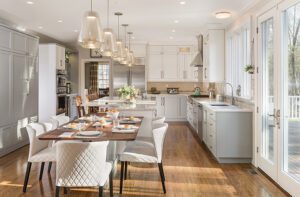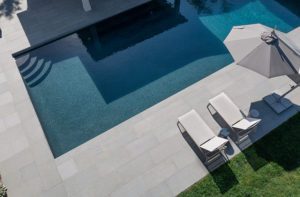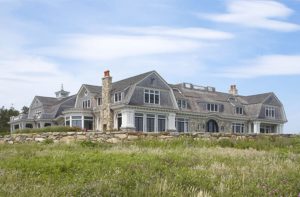How to Choose a Wood Floor That Stands the Test of Time (and Style)
May 8, 2018
SPONSORED CONTENT
Text by Kaitlin Madden
If you’re currently in the process of choosing wood flooring for your home, Mac Davis, owner of Mac Davis Flooring, has some words of wisdom. “In general, everything starts from the bottom up, in life and in your home,” he says.
Davis would know. He started working as an installer for his father’s flooring company at the age of fourteen, and opened his own flooring business in 2006. He has seen—and can’t emphasize enough—the impact the right floor (or the wrong one) can have on a home. “Not all materials are suited for all spaces, especially in a region with four seasons like New England. And style-wise, every couch or cabinet has to work with the floor you choose.”
Here, Davis offers a primer on whittling down the seemingly endless wood and wood-look flooring options available today into the right choice for your home, your style, and your lifestyle.
Start with material.
At the end of the day, your floor has to stand the test of time, so it’s best to focus on material first and consider aesthetics second. “We always start with material and then go to finish. It’s about longevity,” Davis explains. “You don’t want to put something in that looks great if it’s not going to last.”
Davis says his own decision-making process starts by evaluating the lifestyle of the homeowner he’s working with. Everything from whether a family has children or pets, to the location of the home within a region (or even a neighborhood), to whether or not they use air-conditioning in the summer plays a role in finding the right floor.
“If we’re doing a natural wood floor, for example, our number-one priority is finding a product that ensures dimensional stability,” Davis says, referring to a measure of how well a material maintains its original dimensions under temperature and humidity changes. “National wood flooring standards advise that natural wood floors be kept in an environment with 30 percent to 50 percent relative humidity.” In other words, if you live in a climate that’s hot and humid in the summer, air conditioning is a prerequisite for natural wood.
Take advantage of modern engineering.
If you love the look of hardwood floors and letting the breeze in on a warm summer day, however, all is not lost. While hardwood has long been the gold standard in flooring, Davis says he’s seen a shift in recent years—among both the flooring industry and homeowners alike—toward engineered wood products. “Floors used to be all natural oak, but now most are engineered hardwoods because they’re a lot less susceptible to the environment,” he explains. “They don’t expand and contract like natural wood.”
Another plus of engineered wood: durability. “We had one house in downtown Nantucket that’s been flooded multiple times, and the engineered floors we installed are still fine.”
Davis says his most popular flooring option is now an engineered French oak, thanks not only to longevity, but to beauty, because he can apply many of the same finishing and staining techniques to engineered floors that he does to natural options.
Create your perfect finish.
Practicality hasn’t been the only area to benefit from modern developments, however. Davis says that much of his work now involves custom-finished floors created through advanced techniques like fuming or reactive staining. Both processes, he says, are designed to interact with the tannins in the wood, which can result in dramatic color changes that can’t be achieved through traditional stains. “You can put a reactive on white oak that will make it look brown, white, or gray,” he explains. “It gives you a very creative base to start with, and then we often layer colors on top of that, and finish or distress it with wire brushing.”
Davis says the majority of the architects and designers he works with are after a layered or cerused look, which fuels the custom aspect of their business. Gray and white combinations are especially popular. “It tends to be what New England wants, especially in the coastal areas,” he says.
If you’d prefer not to start from scratch, Davis also offers a stocked-custom option. He and his team work with a finish engineering company to create a selection of one-of-a-kind shades that they offer clients through both their Nantucket and Osterville showrooms. “We go up to the [finishing factory] and create our colors, and we then have a collection of engineered woods in exclusive tones,” he explains.
Of course, Davis is also keen to point out that not all of his customers are out to reinvent the classics. Sometimes, especially in New England, tried-and-true is just as coveted. “Knotty pine is something I’ve been installing since I was fourteen,” he says. “It’s been around New England forever. If you were to search photos of New England architecture on Google you’d find plenty of homes with Eastern pine floors in a honey colored stain. It’s been around forever, and it will probably never go away.”
Mac Davis Flooring has two showrooms serving the entire Cape and Islands region.
62 Old South Road
Nantucket, MA
508-228-1027
832 Main Street
Osterville, MA
774-521-3601
Share
![NEH-Logo_Black[1] NEH-Logo_Black[1]](https://www.nehomemag.com/wp-content/uploads/2022/08/NEH-Logo_Black1-300x162.jpg)





















You must be logged in to post a comment.